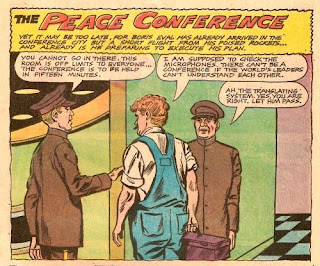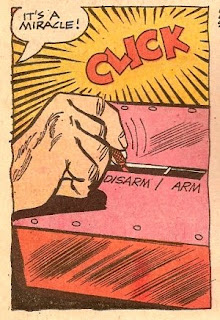

I'm not entirely sure where I got this superhero take on Dracula. I have a vague memory of buying it at some sort of rummage sale they had at my school, along with the comic adaptation of "The Valley of Gwangi," which I had missed in the theater when it was first released. I was probably nine years old at the time, although I may have been ten.
Although the front cover (and as always, you can click on the images for larger, more legible versions) says "COLLECTORS ISSUE," it's actually a reprint of Dell's
Dracula #2, which appeared in 1966. The first issue adapted the Bela Lugosi film, and then Dell, hoping to jump on the superhero bandwagon, transformed Dracula into a costumed adventurer (along with the Frankenstein monster and the werewolf in their own series). The experiment didn't succeed; the series only lasted three issues, ending with #4.
However, in 1972, Dell decided to reprint the books, so Dracula returned with issue #6 (no one seems to know what happened to #5). In this retelling of Dracula's origin, the modern-day Dracula is a medical researcher living in isolation, ashamed of his family's horrible legacy. He is working on a serum to heal brain damage, which he has isolated from the brains of bats in an effort to further rescue his family's reputation.

He finishes the serum and sets the beaker on a shelf, intending to send it to a friend of his for experimental use on asylum patients. Then (before the serum has actually been tested), he sets the bats free
in his lab because he has no further use for them. He then pours himself a toast to his success, a "refreshing glass of mineral water," and apparently doesn't notice that one of the bats set loose in his lab has knocked over the beaker with his precious serum, dumping it into the glass he's about to drink from. What kind of crappy housekeeper is Dracula that he doesn't notice or care about the pink residue in the bottom of the glass he's about to drink out of?
Anyway, he drinks the potion and blacks out. When he comes to, he's flying over the country side, because he has turned into a bat. Wow, good thing he didn't send it to Doctor Schwartz in Vienna for use on all those brain-damaged patients, huh? Imagine fifty mental patients tripping on bat serum flying all over the European countryside.

Anyway, Dracula decides he must shut himself away from the world forever, lest it learn his terrible secret, that secret being that he is a total freaking moron. Alas, it is not to be, for Eastern European strongman Boris Eval trucks up to the castle with a few truckloads of nuclear missiles and sets up shop on Dracula's front lawn.
Eval, who looks like Josef Stalin in a Harpo wig, has an
eval plan (get it?) to take over the world by starting a nuclear war between the superpowers.

Step one: disguised as a common workman with an outrageous mustache and a Harpo wig, Eval plants bombs in an international peace conference. He plans to kill all the officials at the conference, then while the world is in chaos, launch his missiles into space, fooling the superpowers into thinking that each has launched a first strike on the other, triggering a nuclear holocaust. Then, Eval, who is tucked away safely in remote Transylvania, will emerge to claim the reins of power over what's left of the world.
Luckily, the conference is being held within easy bat-flight range of Castle Dracula, so Dracula is able to warn the conferees of the danger. Eval's plot fails.

He still has his nuclear missiles, however, so Dracula next leads a horde of bats in an attack on the missiles. Panicked at the thought of the missiles toppling from the weight of the bats and exploding, Eval flees and wrecks his car. Luckily, his disarming device falls out of the wrecked vehicle, and with one flick of a conveniently labeled switch, Dracula saves the world.
Dracula then decides to use his powers for the good of humanity. He orders a ton of gym equipment delivered to his castle in ominous-looking wooden crates. There follows a quick training montage, in which we learn that T-shirts bulk you up.
Dracula in civilian garb:

Dracula in gym clothes, but still before training of any kind (check out those guns):

Dracula then goes to a nearby village, where he leaves an order with a tailor for a costume, then captures a couple of robbers with his newfound muscles, where this happens:

Did the bullet bounce off? Did the robber miss? Was Dracula wounded, but healed quickly? Or was he wounded and merely fighting through the pain? Who knows? Who cares?
So Dracula picks up his costume and returns home to find his castle in flames. The superstitious townspeople, terrified by all the suspicious deliveries and activity around the castle, have decided to put an end to the evil in their midst. Dracula is appalled at the fear and ignorance of his fellow men, and pledges to fight against evil, corruption and greed in an effort to make people really, really like him.
So ends Dracula's "collectors edition" origin story, at which point nine-year-old you says, "Wait a second! This is a Dracula story
without a vampire! What a rip. I might as well sell this thing to some other idiot at the school rummage sale."
That idiot, of course, was me.

 Built for Pleasure! Programmed for Destruction!
Built for Pleasure! Programmed for Destruction! The story takes place in the near-future. Horny guy buys a sex robot, a busty blonde model called an XTC 69. He wants it to perform S/M on him, but there's a law, called the "Deviate Robot Sex Act," which inhibits her from actually doling out corporal punishment.
The story takes place in the near-future. Horny guy buys a sex robot, a busty blonde model called an XTC 69. He wants it to perform S/M on him, but there's a law, called the "Deviate Robot Sex Act," which inhibits her from actually doling out corporal punishment. Donna Matrix never made it to issue two. The book was printed in expensive full-process color, but the story was mindless, and the computer-generated models were crude and the rendering was often murky. Backgrounds were scarce, poses were stiff, textures were shiny and toy-like--whatever novelty value the 3-D had to offer didn't offset the book's many shortcomings.
Donna Matrix never made it to issue two. The book was printed in expensive full-process color, but the story was mindless, and the computer-generated models were crude and the rendering was often murky. Backgrounds were scarce, poses were stiff, textures were shiny and toy-like--whatever novelty value the 3-D had to offer didn't offset the book's many shortcomings.


















